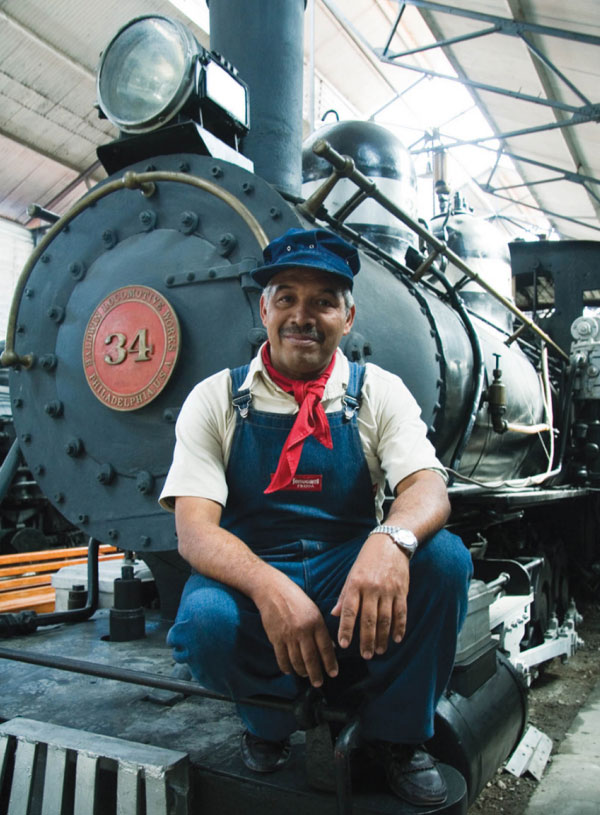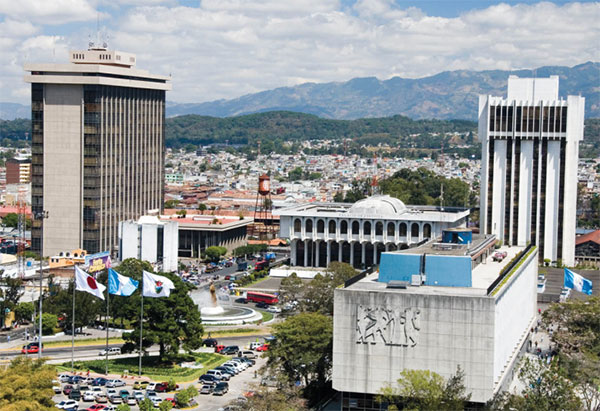Tip
The Patio de la Paz in the western courtyard of the Palacio Nacional features two large brass hands, which commemorate the 1996 signing of the Guatemalan Peace Accords. The schedule changes, but generally the military guard changes the rose held in the brass hands daily at 11am, and the previous one is tossed to a female spectator.
Dominating the east side of the Parque Central is the city Catedral B [map] (www.catedralbicentenaria.org; daily 7am–noon, 3–7pm; free), constructed in a mixture of Baroque and neoclassical styles between 1782 and 1809, though its blue-tiled dome and towers were added later, in 1868. Around the corner from the Catedral is the Mercado Central C [map] (daily 6am–7pm), with a huge variety of textiles, leather goods, basketry, and other handicrafts, as well as food stands on the middle floor serving up a range of caldos (stews), fresh produce, seafood, meat, and snacks. The salmon-pink Correos (post office), on 12 Calle and 7 Avenida, looms just south of the Mercado, with a great arch that spans 12 Calle. A block south is Casa Mima D [map] (8 Avenida; tel: 2253 6657; Mon–Sat 10am–5pm), a beautifully preserved 19th century townhouse with fine period furniture and furnishings. Guatemala City’s former train station has been converted into the excellent Museo del Ferrocarril E [map] (18 Calle and 9 Avenida; tel: 2232 4747; Tue–Fri 9am–4pm, Sat–Sun 10am–4pm), devoted to the history of Guatemalan railroads. There are several superb old steam locomotives, plus a small collection of classic cars and train paraphernalia.

Discover Guatemala’s rail history at the Museo del Ferrocarril.
Corrie Wingate/Apa Publications
If you head west from here you can return to the Parque Central via traffic-free La Sexta Avenida (6th Avenue), a delight to stroll as it takes you past fine 19th-century and Art Nouveau buildings and cafés. The Iglesia de San Francisco F [map] (daily 24hrs) was built in 1780 in an Italianate neoclassical style, and the mortar used to construct it consisted of milk, cane syrup, and egg white. There is a terrific collection of paintings of martyrs, and the relics include the sacred heart of Trujillo. A small but worthwhile museum inside the church houses the belongings of Fray Francisco Vásquez, a Franciscan friar (daily 9am–noon, 3–6pm).
The Centro Cívico – Zona 4
Bridging the divide between the old quarter of Zona 1 and the richer, leafy environs of Zonas 9 and 10 is the cluster of concrete buildings known as the Centro Cívico. The Centro Cultural Miguel Ángel Asturias consists of the elegant Teatro Nacional G [map] (Mon–Fri 9am–4.30pm and for performances), which is set in the remains of the old Spanish fortress of San José – the ancient ramparts are still evident. The views over the city and of the surrounding mountains, including Volcán de Pacaya, are excellent. The cultural complex includes a Greek-style outdoor theater and a chamber-music auditorium. Zona 4 is also home to Inguat, the tourist board headquarters, housed in a large block on 7 Avenida.
Zonas 9 and 10

The upscale Zonas 9 and 10 are bisected by Avenida la Reforma, an attractive tree-lined boulevard. Zona 9, to the west, is dotted with a mix of businesses, mid-range restaurants, and hotels. The main landmark in this part of the city is the Torre del Reformador H [map] , a small-scale imitation of Paris’s Eiffel Tower, erected in honor of Guatemala’s liberal reformer, President Rufino Barrios (1873–85). At the southern end of the boulevard is the Parque El Obelisco, named after the huge obelisk commemorating Guatemalan independence. Zona 10 is the abode of Guatemala’s wealthy elite, with a good proportion of the city’s luxurious hotels, restaurants, and nightlife, as well as top museums. The Jardín Botánico I [map] (Botanical Garden; Avenida La Reforma; tel: 2331 0904; Mon–Fri 8am–3pm), features a diverse range of nearly 1,000 species of Guatemalan plant life, and a small museum, the Museu de Historia Natural, with exhibits on plants, birds, including quetzals, and other indigenous animals. The two biggest attractions in the city are also in Zona 10, inside the verdant grounds of the Universidad Francisco Marroquín. Museo Ixchel del Traje Indígena J [map] (www.museoixchel.org; Mon–Fri 9am–5pm, Sat 9am–1pm), superbly set in a dramatic Maya-esque structure, is dedicated to Maya culture, especially textiles. The museum has a superb collection of huipiles, complete with explanations about the weaving process and the importance of Maya symbolism in the colorful patterns and designs. Looking to bring gifts for those back home? Stop by the museum shop, which has a gorgeous array of textiles, including clothing, napkins, and more. The Museo Popol Vuh de Arqueología K [map] (tel: 2338 7896; Mon–Fri 9am–5pm, Sat 9am–1pm), adjacent to the Ixchel, houses a small range of top-quality archeological artifacts arranged into Preclassic, Maya Classic, Postclassic and Colonial rooms. Also worth a visit, in Zona 13, just to the south, is the Museo Nacional de Arqueología y Etnología L [map] (Tue–Fri 9am–4pm, Sat–Sun 9am–noon, 1.30–4pm), in the Parque Aurora, which has some spectacular Maya art, costumes, masks, and jade artifacts.
Administrative buildings in Centro Cívico (Zona 4).
Corrie Wingate/Apa Publications
Lago de Amatitlán and Volcan de Pacaya
About 30km (18.5 miles) to the south of Guatemala City, following the Carretera del Pacífico, is the lovely Lago de Amatitlán, which is presided over by Volcán de Pacaya 2 [map] , one of the most active volcanoes in Central America. Pacaya is an astonishing sight, especially at night when the finest sound and light show in Guatemala can paint the sky orange with great plumes of lava and gas. Tour agencies in Antigua or Guatemala City can arrange transportation and a guide for the volcano hike.
Antigua
The colonial charm of tranquil Antigua 3 [map] , and its setting amid forest-clad volcanic peaks make it one of the most popular tourist destinations in Guatemala. This former capital abounds in attractions, notably its vast legacy of stunning colonial architecture. The city’s compact size is another factor – walking the cobblestone streets is a pleasure, with cultural and culinary treasures around every corner. Rising over the city are three giant cones: Volcán de Agua, which destroyed the first Guatemalan capital; Volcán de Fuego, active and smoking plumes of gas; and slumbering Volcán Acatenango, the largest but least threatening of the trio.